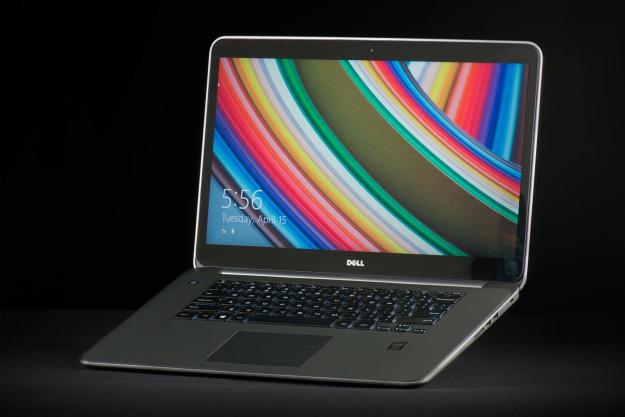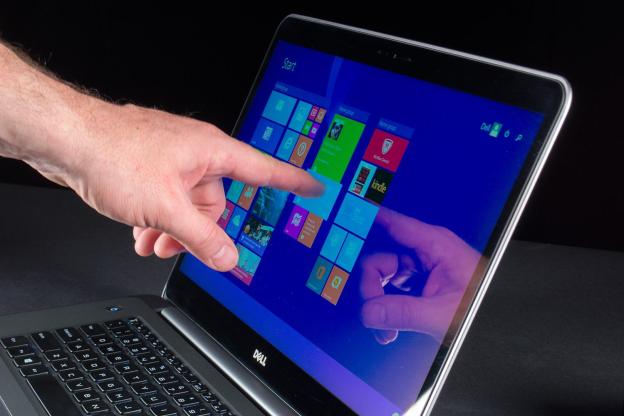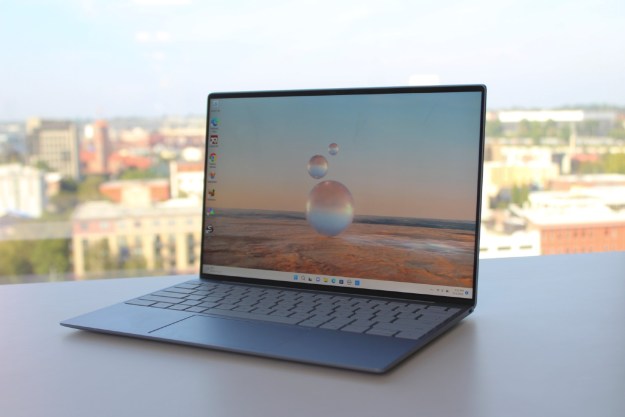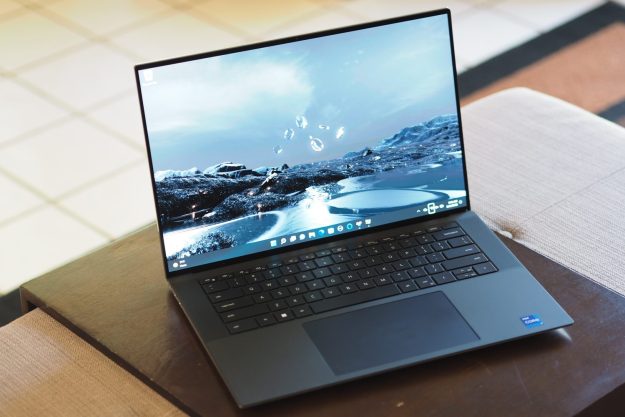
“Extremely quick and built with precision, the XPS 15 falls short of greatness because of its display.”
- Attractive and well-built
- Excellent performance
- Good battery life
- Four USB ports
- Quiet at idle
- Sub-par display quality
- 3200x1800 display saps the GPU’s power in games
- Runs hot and loud at load
Dell’s XPS laptops have long been the Cadillacs of the market. Expensive, luxurious, and powerful, there’s no mistaking an XPS for a lesser system. Yet, there’s also a lingering, and sometimes unfair, sense that the line is second-best.
This arguably stems from Dell’s checkered history. The “Dude, you’re getting a Dell!” shtick still lingers, conjuring up memories of old, boring beige boxes. The latest XPS 15, however, is no such snoozer.
The XPS laptops have arguably become the most luxurious systems in the business.
Then there’s the display, a bold 15.6-inch 3200×1800 panel boasting over 5.7 billion pixels and 235 pixels per inch. That’s 12 more than a MacBook Pro 15 with Retina.
At first glance, Dell’s XPS 15 is a star, but its price tag reaches similar heights as well. The base model, which has a 1080p display, starts at $1,599. However, our review unit, which is upgraded in virtually every area, rings up at an astonishing $2,349.
That’s nearly as much as the top-end Apple MacBook Pro 15 with Retina. So can the XPS 15 out-gun Apple’s best?
Still a looker
The XPS laptops have arguably become the most luxurious systems in the business. Instead of using an aluminum case or unibody shell, Dell has committed to a carbon fiber chassis reinforced by a metal frame and display lid. This creates a silver-on-black aesthetic that’s striking, yet professional, and rids the XPS 15 of the chassis flex that plagues many laptops that are built using carbon fiber.

The positive first impressions we got continued when we handled the XPS 15, thanks to a luxurious soft-touch finish employed along the interior and bottom. This provides a warmer, more inviting feel than the MacBook Pro 15’s bare metal finish does.
Though the XPS 15 does a good job of keeping fingerprints at bay, once one is present, some grunt is required to remove it. In other words, don’t use the XPS 15 after eating fried chicken or chips.
Connectivity includes four USB ports, three of them 3.0, along with HDMI, DisplayPort, a combo headphone/microphone jack, and a memory card reader. An Ethernet jack is not included, but 802.11ac Wi-Fi is standard.
Classy keyboard
Despite its size, the Dell XPS 15 doesn’t include a number pad, and doesn’t offer a spacious layout. This may annoy accountants and other number crunchers, but dropping the numpad increases the size of the palm rest. This makes typing more enjoyable for people with large hands. Users will also enjoy the laptop’s significant key travel, and good tactile feel.
Keyboard backlighting is standard, but offers only two brightness settings, neither of which are brilliant. There’s minimal light leak though, so the backlight at least gets the job done.
The touchpad, which is about four inches wide by three and a quarter inches tall, provides good multi-touch gesture support. Scrolling feels a bit skittish by default, but can be toned down in Windows 8.1’s settings, and we had few problems with accidental activation of swipe while multitasking. Credit for this probably goes to Microsoft, however, as the company toned down the sensitivity of some gestures in Windows 8.1 Update 1.
A disappointing display, but decent speakers
The glossy 3200×1800 touchscreen included in our review unit features a thin-bezel edge-to-edge design constructed with Corning’s Gorilla Glass. Touch functionality is silky-smooth thanks to the use of a proper glass material. Glare can be an issue, but the display’s maximum brightness of 400 nits can usually overpower reflections.
Apple’s Retina display has fewer pixels, but makes up for those flaws with far superior image quality.
We also saw obvious red push. In a stand-up segment from Conan, for example, his face appeared scarlet and puffy, as if he walked on stage after eating a bowl of chili.
None of this compares well to the displays on other notebooks. The Toshiba Kirabook, for example, managed a contrast ratio of 590:1, while the much less expensive Acer Aspire R7 scored 780:1. We haven’t reviewed the latest MacBook Pro 15 with Retina, but other publications have coaxed it into producing a ratio of almost 900:1.
The scaling problems common to high-resolution Windows notebooks persist as well. 1080p video contains less than half the pixels that the 3200×1800 screen can handle, and scaling the source up to the display creates a soft, blurry look. Heaven help the poor souls who must watch 720p clips!

At least the speakers exceeded our expectations. Loud, full and free of distortion, they provide good sound quality for a laptop, and can easily fill a room with music. The only problem we noted was an odd vibration at high volume and certain frequencies.
Quad-core struts its stuff
Our review unit’s Intel Core i7-4702HQ CPU propelled the XPS 15 to a SiSoft Sandra Processor Arithmetic score of 98 GOPS, and a 7-Zip score of 17,923 MIPS. These numbers beat out the preceding Dell XPS 15, which scored 15,389 MIPS, and are just a hair behind the Asus G750 gaming laptop, which scored 19,634. Ultrabooks, like the Toshiba Kirabook, which reached 7,403, don’t even come close.
We also recorded a strong PCMark 8 storage bench result of 4,929. Most systems with a solid state drive score near 5,000. The sheer size of the XPS 15’s SSD is exceptional; at 512GB, it dwarfs the 128GB drives found in most Ultrabooks.
3DMark proved that the XPS 15’s Nvidia GT 750M graphics card is capable, generating a Cloud Gate score of 10,272, and a Fire Strike grade of 1,956. These are excellent scores. In fact, they nearly tie the ASUS M70AD desktop we just reviewed.
The display is the great un-equalizer, however. At 1080p, the GT 750M could be a light-duty gaming laptop (ironically, the 1080p model is stuck with Intel HD graphics). But what about 3200×1800? To find out, we fired up League of Legends, a game that, though popular, doesn’t demand much in terms of system requirements to run it.
League of Legends benchmarks
We got an average of 40 frames per second with the game set to Medium detail, with a maximum of 49 and a minimum of 29. At Very High detail, the average was reduced to 33 FPS, with a max of 44 and min of 21.
These are playable frame rates, but they’re low given the hardware that the XPS 15 packs. A Dell XPS 13 scores better at Medium detail in spite of its Intel HD 4400 graphics, because games run natively at 1080p. You can run games at a lower resolution on the XPS 15, of course, but be warned that graphics will have a soft appearance, and in-game text will look a bit blurred.
Portable powerhouse
Measuring up to seven-tenths of an inch thick and 14.6 inches wide, the XPS 15 is not what most consumers would consider to be portable. Instead, it feels like any other desktop replacement, albeit a light one, as the system weighs in at just under 4.5 pounds.
The standard 61Wh battery lasted over 6 hours in our benchmark, an impressive result for a large, powerful laptop.
Our watt meter caught the XPS 15 consuming 18 watts at idle with the display at maximum brightness, though reducing it to 50 percent lowered consumption to 15 watts. These are relatively high figures. An Ultrabook like the Toshiba Kirabook eats a maximum of 10 watts at idle.
Power consumption at load spikes even higher, reaching a maximum of 85 watts. That’s the highest power draw we’ve recorded since the Origin EON 13-S, which swallowed up to 91 watts. With that said, high power draw is not unexpected. Powerful hardware doesn’t work without a steady supply of wattage.
Quiet, except when it’s not
At idle, the XPS 15 is a surprisingly serene laptop. The fan, which puts out 35.5 decibels, barely stands out from ambient noise. Peace is maintained even when the processor is at full load; the fan doesn’t spin up at all.
When gaming on the XPS 15, the story changes. A demanding title can force the fan into action, spiking noise as high as 51.1db. That’s absolutely noticeable in any home or office, and loud enough to annoy users who prefer silence.
Even so, the fan struggles to provide enough cooling. At idle, we recorded a maximum external temperature of 100 degrees Fahrenheit. Gaming inflated that figure as high as 117.7 degrees. Overall, the XPS 15 is the warmest system we’ve reviewed since the Acer Aspire V7.
Conclusion
Dell’s XPS 15 is a system of extremes. The display provides incredible sharpness, but its quality is well below average. The processor and video card perform well, but the fan struggles to cool them at full load. The 512GB solid state drive is massive, but contributes to the notebook’s hefty $2,349 asking price.
The Apple MacBook Pro 15 with Retina is the XPS 15’s only direct competitor. The upgraded version of the Pro, which boasts an Intel Core i7 quad core CPU, 16GB of RAM, a 512GB SSD, and Nvidia GeForce GT 750M graphics, sells for $2,599. Apple’s alternative is better overall, but the gap between the two mostly comes down to the display. The Retina display has fewer pixels and lacks touch, but makes up for those flaws with far superior image quality.
We doubt that the $250 gap between the two will make buyers think twice given that both sell above two grand, but one runs Windows, and one runs OS X. That alone is a significant difference, and with no other direct competitors available, the operating system becomes a deciding factor.
Do you need a beastly Windows notebook and aren’t fazed by the prospect of paying more than $2,000 for one? Buy the Dell XPS 15. Don’t need a Windows laptop? Buy the MacBook Pro 15 with Retina. The choice really is that simple.
Highs
- Attractive and well-built
- Excellent performance
- Good battery life
- Four USB ports
- Quiet at idle
Lows
- Sub-par display quality
- 3200×1800 display saps the GPU’s power in games
- Runs hot and loud at load
Editors' Recommendations
- Dell XPS vs. Dell Latitude: here’s how to decide
- Dell XPS 14 or XPS 16? Here’s how to know which to buy
- Best Dell XPS deals: Save on Dell XPS 13, Dell XPS 15 and Dell XPS 17
- 9 best laptops of 2024: tested and reviewed
- Best Dell laptop deals: Cheap laptops starting at $280










